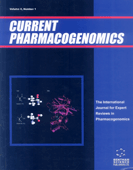Abstract
Purpose of review: The purpose of this review is to summarize recent advances in the area of genetic polymorphisms in genes affecting immunosuppressive drug bioavailability with a specific emphasis on solid organ transplantation. Recent findings: Due to recent advances in molecular techniques, there has been an abundance of publications describing genetic variability in molecules relevant to pharmacogenetics. The initial studies in the field of transplantation demonstrate some associations between polymorphisms in these candidate genes with outcomes in organ transplantation.
Keywords: Transplantation, genetic polymorphisms, immunosuppressive drug, bioavailability
Current Pharmacogenomics
Title: Genomic Strategies in Transplantation “The Right Drug for the Right Patient”
Volume: 2 Issue: 2
Author(s): Bernd Schroppel
Affiliation:
Keywords: Transplantation, genetic polymorphisms, immunosuppressive drug, bioavailability
Abstract: Purpose of review: The purpose of this review is to summarize recent advances in the area of genetic polymorphisms in genes affecting immunosuppressive drug bioavailability with a specific emphasis on solid organ transplantation. Recent findings: Due to recent advances in molecular techniques, there has been an abundance of publications describing genetic variability in molecules relevant to pharmacogenetics. The initial studies in the field of transplantation demonstrate some associations between polymorphisms in these candidate genes with outcomes in organ transplantation.
Export Options
About this article
Cite this article as:
Schroppel Bernd, Genomic Strategies in Transplantation “The Right Drug for the Right Patient”, Current Pharmacogenomics 2004; 2 (2) . https://dx.doi.org/10.2174/1570160043377600
| DOI https://dx.doi.org/10.2174/1570160043377600 |
Print ISSN 1570-1603 |
| Publisher Name Bentham Science Publisher |
Online ISSN 1570-1603 |
 2
2Related Articles
-
Targeting Telomerase by Antisense-Based Approaches: Perspectives for New Anti-Cancer Therapies
Current Pharmaceutical Design The MRP Family and Anticancer Drug Metabolism
Current Drug Metabolism Molecular Profiling - An Essential Technology Enabling Personalized Medicine in Breast Cancer
Current Drug Targets The Therapeutic Value and Molecular Mechanisms of lncRNA FENDRR in Human Cancer
Current Pharmaceutical Design Cellular Photodynamic Toxicity of Hematoporphyrin in Various Nanocarrier Systems
Current Nanoscience Stress Related Neuroendocrine Influences in Ovarian Cancer
Current Cancer Therapy Reviews Combination Platinum-based and DNA Damage Response-targeting Cancer Therapy: Evolution and Future Directions
Current Medicinal Chemistry Cyclopamine, a Naturally Occurring Alkaloid, and Its Analogues May Find Wide Applications in Cancer Therapy
Current Topics in Medicinal Chemistry Recent Developments of Platinum-based Anticancer Drugs- Detection and Analysis in Biological Samples
Current Organic Chemistry Approaches for the Inhibition of Human Telomerase Based on the Use of Peptide Nucleic Acids and Hammerhead Ribozymes
Mini-Reviews in Medicinal Chemistry Bortezomib as the First Proteasome Inhibitor Anticancer Drug: Current Status and Future Perspectives
Current Cancer Drug Targets Targeting Sphingosine-1-Phosphate Receptors in Cancer
Anti-Cancer Agents in Medicinal Chemistry Preclinical Models to Study Breast Cancer
Clinical Cancer Drugs Synthesis, Antioxidant, Anticancer and Antiviral Activities of Novel Quinoxaline Hydrazone Derivatives and their Acyclic C-Nucleosides
Medicinal Chemistry Impact of Magnetic Nanoparticles in Biomedical Applications
Recent Patents on Drug Delivery & Formulation Drug Therapy of Neuropathic Pain: Current Developments and Future Perspectives
Current Drug Targets Combination of Anti-EGFR Drugs with Anti-Angiogenic or Other Signal Transduction Inhibitors as a Rational Approach to Cancer Therapy
Current Cancer Therapy Reviews Small Molecule Aurora Kinases Inhibitors
Current Medicinal Chemistry Anti-HER2 Therapy in Elderly Breast Cancer Patients
Reviews on Recent Clinical Trials Aluminofluoride Complexes: Phosphate Analogues and a Hidden Hazard for Living Organisms
Current Inorganic Chemistry (Discontinued)













.jpeg)








